
A tractor is an engineering vehicle specifically designed to deliver a high tractive effort at slow speeds, for the purposes of hauling a trailer or machinery such as that used in agriculture, mining or construction. Most commonly, the term is used to describe a farm vehicle that provides the power and traction to mechanize agricultural tasks, especially tillage, but nowadays a great variety of tasks. Agricultural implements may be towed behind or mounted on the tractor, and the tractor may also provide a source of power if the implement is mechanised.
The Locomobile Company of America was a pioneering American automobile manufacturer founded in 1899, and known for its dedication to precision before the assembly-line era. It was one of the earliest car manufacturers in the advent of the automobile age. For the first two years after its founding, the company was located in Watertown, Massachusetts. Production was transferred to Bridgeport, Connecticut, in 1900, where it remained until the company's demise in 1929. The company manufactured affordable, small steam cars until 1903, when production switched entirely to internal combustion-powered luxury automobiles. Locomobile was taken over in 1922 by Durant Motors and eventually went out of business in 1929. All cars ever produced by the original company were always sold under the brand name Locomobile.
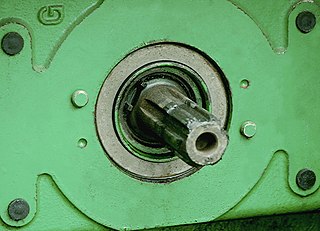
A power take-off or power takeoff (PTO) is any of several methods for taking power from a power source, such as a running engine, and transmitting it to an application such as an attached implement or separate machine.
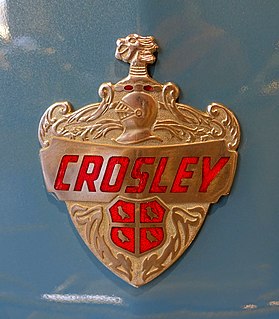
Crosley was a small, independent American manufacturer of subcompact cars, bordering on microcars. At first called the Crosley Corporation and later Crosley Motors Incorporated, the Cincinnati, Ohio, firm was active from 1939 to 1952, interrupted by World War II production. Their station wagons were the most popular model, but also offered were sedans, pickups, convertibles, a sports car, and even a tiny jeep-like vehicle. For export, the cars were badged Crosmobile.

The International Harvester Company was an American manufacturer of agricultural equipment, automobiles, commercial trucks, lawn and garden products, household equipment, and more. It was formed from the 1902 merger of McCormick Harvesting Machine Company and Deering Harvester Company and three smaller manufactures: Milwaukee; Plano; and Warder, Bushnell, and Glessner. In the 1980s all divisions were sold off except for International Trucks, which changed its parent company name to Navistar International. Its brands included McCormick, Deering, and later McCormick-Deering, as well as International. Along with the Farmall and Cub Cadet tractors, International was also known for the Scout and Travelall vehicle nameplates. Given its monumental importance to the building of rural communities the brand continues to have a massive cult following. The International Harvester legacy non-profits host some of the largest agriculture related events in the United States.
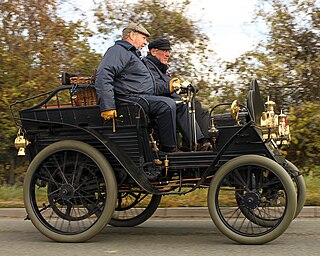
The Mors automobile factory was an early French car manufacturer. It was one of the first to take part in automobile racing, beginning in 1897, due to the belief of the company founder, Émile Mors, in racing's technical and promotional benefits. By the turn of the century, automobile racing had become largely a contest between Mors and Panhard et Levassor.

The Case Corporation was a manufacturer of construction equipment and agricultural equipment. Founded, in 1842, by Jerome Increase Case as the J. I. Case Threshing Machine Company, it operated under that name for most of a century. For another 66 years it was the J. I. Case Company, and was often called simply Case. In the late 19th century, Case was one of America's largest builders of steam engines, producing self-propelled portable engines, traction engines and steam tractors. It was a major producer of threshing machines and other harvesting equipment. The company also produced various machinery for the U.S. military. In the 20th century, Case was among the ten largest builders of farm tractors for many years. In the 1950s its construction equipment line became its primary focus, with agricultural business second.

The PSA X engine is a family of internal combustion engines used in Citroën, Peugeot, Talbot and Renault automobiles. The X family was mainly used in superminis and the entry level models of midsize vehicles. It is commonly called the "Douvrin" or the "Suitcase" engine. It was designed and manufactured by the company "Française de Mécanique," a joint venture created by Peugeot and Renault in 1969.
F. B. Stearns and Company, later known as F.B. Stearns Company was an American manufacturer of luxury cars in Cleveland, Ohio marketed under the brand names Stearns from 1900-1911 then Stearns-Knight from 1911 until 1929.
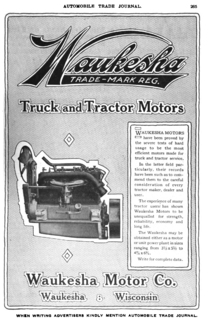
Waukesha is a brand of large stationary reciprocating engines produced by INNIO Waukesha Gas Engines, a business unit of the INNIO Group. For 62 years, Waukesha was an independent supplier of gasoline engines, diesel engines, multifuel engines (gasoline/kerosene/ethanol), and LNG/propane engines to many truck, tractor, heavy equipment, automobile, boat, ship, and engine-generator manufacturers. In 1906, the Waukesha Motor Company was founded in Waukesha, Wisconsin. In 1957, Waukesha bought the Climax Engineering Co. of Clinton, Iowa, also a noted builder of large engines. In 1968, Waukesha Motor Company was acquired by the Bangor-Punta Corporation. In 1973, Waukesha sold the Climax division to the Arrow Engine Company. In 1974, Waukesha Motor Company was sold to Dresser Industries and became Dresser's Waukesha Engine Division; its typical nicknames afterward were Waukesha Engine and Dresser Waukesha. In 1989, Dresser acquired the Brons company of the Netherlands. In 2010, Dresser, including Dresser Waukesha, was acquired by GE Energy. On January 20, 2014, Barack Obama visited the plant where he gave a speech on increasing the minimum wage to $10.10 an hour. He also discussed wage equality for women. Afterwards he took a tour of the plant. On September 28, 2015, GE announced it was closing the plant for good and moving the engine manufacturing operations to Canada. In November 2018 INNIO announced that Advent International has completed the acquisition of GE’s Distributed Power business, being a stand-alone energy company rebranded as INNIO. The transaction included the Jenbacher and Waukesha product lines, the digital platform and related services offerings, with main operating sites in Austria, Canada and the United States. Since July 2019 the Waukesha and Jenbacher business units service their segments and customers around the world as independent entities under the INNIO umbrella brand.

The Avery Company, founded by Robert Hanneman Avery, was an American farm tractor manufacturer famed for its undermounted engine which resembled a railroad engine more than a conventional farm steam engine. Avery founded the farm implement business after the Civil War. His company built a large line of products, including steam engines, beginning in 1891. The company started with a return flue design and later adapted the undermount style, including a bulldog design on the smokebox door. Their design was well received by farmers in central Illinois. They expanded their market nationwide and overseas until the 1920s, when they failed to innovate and the company faltered. They manufactured trucks for a period of time, and then automobiles. until they finally succumbed to an agricultural crisis and the Depression.
The Hackett was an automobile built in Jackson, Michigan, United States, by the Hackett Motor Car Company from 1916 to 1919.
The Austin was a brass era American automobile manufactured in Grand Rapids, Michigan from 1901 to 1921. The company, founded by James E. Austin and his son Walter Austin, built large, expensive and powerful touring cars with an unusual double cantilever rear spring arrangement placing the rear wheels behind the passenger compartment, for a longer wheelbase to improve rider comfort in an era of rough roads as well as a unique two-speed rear axle.

The M6 High-Speed Tractor was an artillery tractor used by the US Army during World War II.
Continental Motors Company was an American manufacturer of internal combustion engines. The company produced engines as a supplier to many independent manufacturers of automobiles, tractors, trucks, and stationary equipment from the 1900s through the 1960s. Continental Motors also produced automobiles in 1932–1933 under the name Continental Automobile Company. The Continental Aircraft Engine Company was formed in 1929 to develop and produce its aircraft engines, and would become the core business of Continental Motors, Inc.
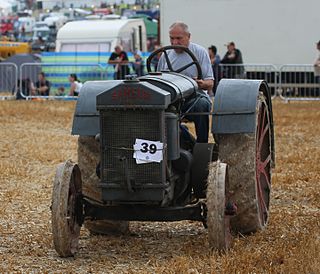
Samson Tractor was an American brand of tractors 1900 to 1923, of trucks from 1920 to 1923, and a General Motors brand from 1917 to 1923.

The Bethlehem Motors Corporation was a manufacturer of tractors, automobiles and trucks in Allentown, Pennsylvania, between 1917 and 1926.
The Multiplex was an automobile built in Berwick, Pennsylvania by the Multiplex Manufacturing Company from 1912 to 1913. The Multiplex was a sporty, upper-prized and large car equipped with a four-cylinder engine, and offered as a Touring, a Roadster, and a Raceabout. A prototype "Sports" car with an 85 inches (2,200 mm) wheelbase, weighting in at just 980 pounds (440 kg) and allegedly capable of a top speed of 126 mph (203 km/h) was also built.
The Hercules DFXE is an American diesel truck engine.

The Packard Twelve was a range of V12-engined luxury automobiles built by the Packard Motor Car Company in Detroit, Michigan. The car was built from model year 1916 until 1923, then it returned 1933 until 1939. As a sign of changing times, the majority of second generation Packard Twelves received standard bodywork, with custom bodywork gradually losing favor. Many of the custom cars were actually only "semi-customs", with Dietrich assembling Packard-made bodies with special touches. The first generation engine was modified for military use and became the Packard 1A-2500 which began usage in 1924.













